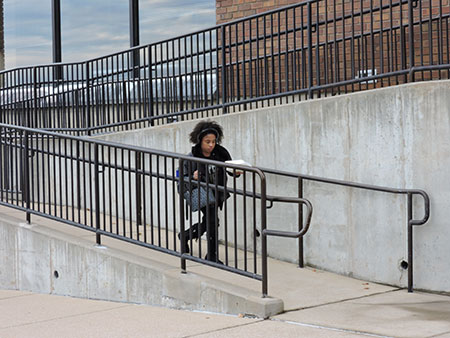
By Jason Ethridge
The Scene staff
Forest Park was built in 1967, more than 20 years before the American with Disabilities Act began requiring public places to be accessible to people with disabilities.
Campus buildings have elevators, automatic doors and wheelchair ramps, but navigation still can be a challenge.
“There are spots that are not accessible, which you find in a lot of large campuses similar to this one,” said Kim Lackey, director of public policy and advocacy with Paraquad. “There are definitely places that have room for improvement to provide maximum accessibility.”
Paraquad is a non-profit organization that works to empower people with disabilities and help them become more independent. Its headquarters is less than a block from Forest Park.
At The Scene’s request, Lackey surveyed the campus recently with Christopher Worth, 40, an organizing team manager with Paraquad who has cerebral palsy.
They found cramped quarters in several bathrooms; mechanical malfunctions with automatic doors in D and E towers; and non-automatic doors that are harder to open than is recommended by Paraquad.
Such problems don’t prevent people with mobility issues from getting around, but they can make it more difficult and time-consuming.
“I would give Forest Park a C-plus or B-minus,” Worth said, speaking of its overall accessibility.
Forest Park has 250 students with physical or mental disabilities, compared to a total enrollment of 5,321 students this semester.
Small elevators, high shelves
Paige Karius, founder of the Disabilities Awareness Club, has dealt with some of the problems detailed by Lackey and Worth. She has cerebral palsy and uses a wheelchair.
Karius can barely fit in most elevators on campus because they are too small. It’s easier for her to go to E Tower and ride the large freight elevator, which is notoriously slow.
“Once you learn the area, you kind of know the shortcuts and backways to get around,” said Karius, 23, a special education teaching major. “I don’t know if that’s a good thing or a bad thing.”
The Forest Park library is another place Karius faces challenges.
Some shelves can only be accessed by going upstairs on a tiny elevator behind the staff office. Maneuvering it in a wheelchair is like “fitting puzzle pieces together,” Karius said.
Karen Kacer, reference librarian and archivist, is aware of these accessibility problems. She often volunteers to be a “student’s legs,” making trips to the second floor and finding books for students, or just lending a hand to reach materials on high shelves.

Big changes are expensive
Sometimes librarians direct students to digital media that may be easier for them to use.
“We are doing our utmost to fill in the gaps and everything we can to help,” Kacer said.
Lackey and Worth made several recommendations to bring Forest Park’s accessibility in line with modern standards. That includes adding automatic doors and installing swing hinges on non-automatic doors to provide extra clearance.
Lackey also suggested better accommodations for visually-impaired students, such as more braille in signage, high-contrast floor markings on stairs and easier-to-read elevator buttons.
Many changes that would be required to provide maximum accessibility at Forest Park are prohibitively expensive, according to Scott Armstead, districtwide assistive technology coordinator for St. Louis Community College.
“You’re talking tearing walls down, tearing floors up,” he said of what would be involved in replacing a single elevator. “It could be multiple millions of dollars.”
Such costs would be considered “undue hardship” under the ADA’s guidelines, so Forest Park isn’t legally obligated to make major modifications, according to Armstead.
In other words, some problems are simply too expensive to fix, he said.
Praise for some features
Not all of Paraquad’s feedback on Forest Park accessibility was negative. Worth was particularly impressed with low-standing sinks in several bathrooms, noting how much easier they are for people in wheelchairs to use than standard sinks.
Lackey liked high-contrast signage in the basement hallway between C and D towers and outside the Academic Support Center.
At that location, there’s also a motorized lift to transport wheelchairs up and down a steep ramp.
Apart from navigation, Forest Park has an Access Office, which does what it can to help students with disabilities be successful in college.
“We offer academic coaching, note takers, test proctors and even lab assistants,” said Telitha Rogers, office manager.
Access Office staff will speak with instructors on students’ behalf if special accommodations are needed for them to complete class requirements.
They also loan tape recorders and other equipment; provide audio texts, paper enlargements and other accessible media; and offer services such as sign-language interpretation and speech transcription.
The college welcomed Johnathan Mooney, an expert on mental and physical disabilities, to a recent Professional Development Day at Forest Park.
“There has been a focus on accessibility from the administration,” Rogers said.
